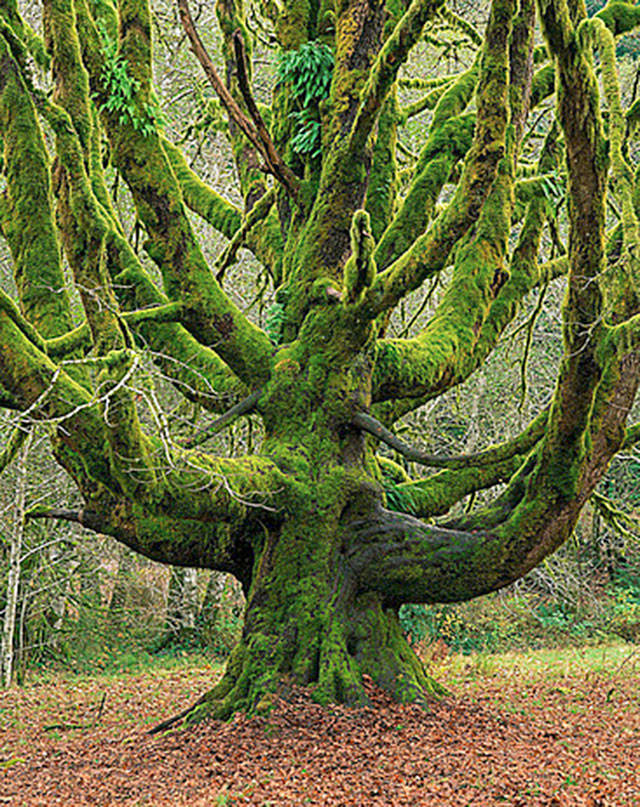Editor’s note: To see enormous bigleaf maples locally, go west across the bridge in Railroad Bridge Park.
Geez, I’m such a wimp. Winters around here are shorter than my gnat-like attention span, but I’ve still been whining for spring since the leaves fell.
Thankfully, the bigleaf maples have finally awakened from winter naps in their usual dignified style.
If you saw their exotic dangling clusters of greenish-white flowers on a trip to the tropics, your jaw would drop, but here they’re so common we tend to walk right past. Somehow I didn’t notice them until I was about 40 but now look forward to them every spring.
Those lovely flowers don’t smell like much but eventually they produce the familiar golden brown helicopter fruits called samaras that whirl away on fall gales or when flung from the hands of smiling kids.
As I’m sure you’ve noticed, these guys can be majestically big, and like nobility, often live for decades in states of partial decay, with some of the multiple trunks dead and rotting away while other parts live on happily. The bark of young trees starts out a pretty smooth gray, but gives way to a wrinkly roughness as it ages (sounds familiar).
All those stationary nooks and crannies give moss and small plants a place to get going, which is another good reason none of us should lay around on the couch too much.
As you go west from Sequim, the moss gets more and more luxuriant until by the time you reach Lake Crescent, maples look like trees trying to join the world of mammals, but just not quite figuring it out yet. “Dripwater” from fog or rain, enriched by the poop of canopy-dwelling birds, insects, etc., runs down the trunks, nourishing a dense miniature forest full of bizarre spiders, insects and centipedes.
I once stuck my arm into some of this living cushion over around the Hoh and was up to my elbow before touching bark. Older trees actually grow tiny roots out of their trunks into the nutrient-rich mossy “soil” to try to grab some of the goodies before they run onto the ground.
And we think we invented recycling.
Those leaves that are sometimes so big they just make you laugh are almost always from the lower branches down there in the dim. If it’s dry and a little frosty in fall, they turn a welcome bright yellow, but back east their cousins put on a roadside show so bright you’ll drive right into the ditch if you aren’t careful. You ever notice those little splatters of green and black on the yellow fall leaves?
Well, in the fall, deciduous trees usually try to save those expensive green pigments to use them again next year by pulling them back into the trunk and roots for the winter. Those clustered black dots are a fungus called Rhytisma, or “tar spot” that sequesters chlorophyll for its own diabolical ends. Look for little splatters of black on a green background on yellow leaves in fall.
Bigleafs are the biggest of all the maples, sometimes with immense limbs on which you’d only be half surprised to see a lounging troop of gorillas. They range from southwestern British Columbia south to northwest California, seeming to prefer rich valley soils where for some reason Douglas-firs failed to take over. The optimistic sprouts from cut or burnt stumps can grow over 12 feet in one year.
Natives used the leaves as temporary containers and the dense wood was and still is used to make cooking utensils and paddles. Some part(s) of the tree were used to make an infusion to treat sore throats and the Sannich rubbed the leaves on a young man’s face so he wouldn’t grow whiskers.
The sap makes a decent syrup, but it takes something like 75 gallons of it to make one gallon of the pancake-ready stuff. I know at least one guy who eats the flower clusters battered and fried in butter. Nowadays maple wood is pretty valuable for furniture and flooring.
Crazy grain types like “fiddleback,” “quilted” and “birds-eye” trick the eye into seeing otherworldly landscapes on glass-smooth tabletops and can be really spendy.
A lot of it is sold in smaller pieces for making musical instruments. Apparently, Carlos Santana’s favorite electric guitar is made of bigleaf maple.
Tom Butler has a degree in zoology from the University of Washington and is a lifelong student of nature. He lives in Port Angeles and can be reached at butlert@olypen.com.



